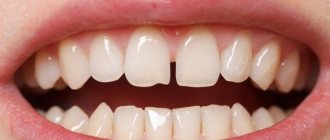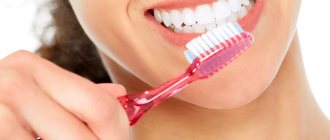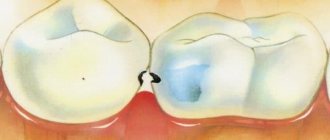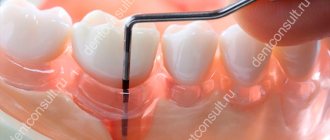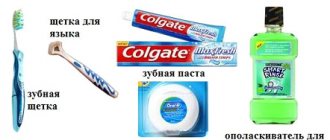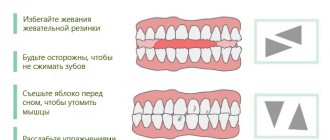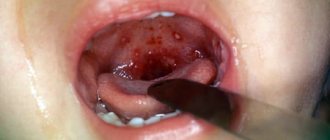Why there may be a gap between the front teeth
The causes of diastema (this is what the gap between the front teeth is called) are speculative. In this case, the hereditary factor plays a significant role. If in children a gap appears as a result of changing teeth (although the phenomenon can also be observed on baby teeth), then in adults the formation of a gap occurs gradually and steadily over time. This means that the dentist will have to not only remove the gap, but also eliminate the cause of its occurrence.
The main causes of diastema include:
- genetic predisposition - the formation of the lumen follows the parental type;
- pathology of periodontium and tooth position;
- the patient has too small teeth (microdentia);
- late formation and eruption of the central incisors when changing teeth to permanent ones;
- removal of anterior teeth without subsequent rapid prosthetics;
- incorrect (too low) fastening of the labial frenulum, compaction of the cord of the upper lip frenulum;
- presence of supernumerary teeth;
- injuries to the jaw and front teeth.
It is noteworthy that bad habits - gnawing, sucking and even cracking seeds - can lead to the appearance of a gap between the teeth.
Composite restoration
Often, dentists, when patients ask how to close the gap between the front teeth, recommend reconstruction with composite materials. This method is used only to eliminate gaps between incisors, canines and slight curvature.
Result after correction.
Composites are elastic photopolymer materials. They are applied in layers and harden under a special lamp - a photopolymerizer. At the end, the dentist must remove excess fillings, polish and grind.
Advantages of composite restoration:
- Fast: recovery takes from 30 minutes to 2 hours.
- The procedure is carried out in one visit.
- Painless.
- No need to grind down the enamel.
Important! A composite restoration retains the ability to correct the bite in other ways at any time. The method gives time to think about what to do next in case of serious defects.
Composites have significant disadvantages :
- Average service life is 5 years.
- Restored teeth will need to be polished and fluoridated regularly.
- Fragility.
- Due to their porous structure, composites change color within 2–3 years.
Is it possible to get rid of gaps between teeth?
Closing the gap between teeth is not only possible, but also necessary. If the problem is not addressed in time, diastema can lead to periodontitis. In addition, the cleft contributes to the appearance of speech defects such as a lisp, whistling, and hissing. The psycho-emotional component is of no small importance - a person tries to protect himself from communication, becomes closed and complex.
In some cases, when changing teeth, the gap that appears may close on its own, even in the presence of hereditary pathologies. But this does not mean that you should ignore regular visits to the dentist.
Vining
Large gaps between teeth are preferably corrected with veneers – ceramic plates. Their thickness does not exceed 0.7 mm, they are attached to the enamel and completely restore the aesthetics and functionality of the jaw.
Important! Veneers are made from individual impressions by a dental technician. The color and size of the plates fully correspond to the patient’s natural bite.
Veneers are one of the methods for correcting gaps between teeth.
Advantages of veneers:
- The plates are indistinguishable from natural teeth.
- Long service life - from 10 years.
- Increased strength.
- Allows you to correct many crooked teeth at the same time.
Flaws:
- The enamel is ground down.
- The duration of the procedure is 2 – 3 weeks.
- After the installation of the plates, restoration using other methods other than prosthetics is impossible.
The cost of veneering varies from 15 to 25 thousand rubles.
Classification of diastemas
The phenomenon can be classified according to several fundamental characteristics. Treatment is prescribed after the type of disease has been established and the individual characteristics of the patient have been clarified.
Diastemas are classified
By time of occurrence:
- False - pathology is characteristic of an early age, when the bite is not yet formed. During the process of changing teeth, it disappears on its own, without third-party intervention.
- True - develops after the change of teeth and the formation of a bite, as well as in adults due to injuries, periodontal pathologies or untimely prosthetics.
Important. In adults, a cleft that appears will not disappear on its own. To eliminate the defect, you need to visit a doctor.
By location:
- symmetrical - the incisors are located symmetrically relative to each other and the conditional center of the dentition;
- asymmetrical - one of the incisors deviates to the side, the second takes its natural position.
According to the position of teeth and roots:
- Lateral deviation of the head. Assumes lateral deviation of the incisors with the correct position of the roots. Typically, a similar situation is observed with supernumerary teeth. The diastema is usually small in size.
- Corpus lateral displacement. It is a lateral displacement of the tooth along with the root. One of the reasons is compacted bone tissue along the median seam, which prevents teeth from erupting in the right place.
- Medial inclination of the central incisors of the crowns, the most difficult case. Both teeth and roots shift. In this case, the crowns can grow to the sides or move around their axis.
Ways to correct gaps between teeth
The choice of treatment method depends on the type of diastema, its size, and the general condition of the periodontium. The doctor offers a correction method that can eliminate the defect as quickly as possible for the patient. Restoration may require from one or two procedures to several years.
Braces
One of the most reliable options for closing the gap between the central incisors is braces. Modern braces systems are made from ceramics, plastic, metal or a combination. They are made individually for each patient, based on X-ray examination data and casts. Individual elements are installed on the outside or inside of the teeth, fastening them together with a metal thread.
Installation of a non-removable orthopedic structure makes it possible to make the dentition perfectly straight, eliminating not only diastema, but also other jaw pathologies. The method is safe and effective. Recommended for young people, when the skeletal system has not yet fully formed.
Disadvantages:
- Long time to correct defects – up to three years. Moreover, the older the patient, the longer the treatment lasts.
- Regular visits to the dentist to adjust the braces system. After examination, the doctor adjusts the tension of the ligature, shifting the emphasis to the right places.
- Careful, regular and more serious oral hygiene.
The estimated cost of treatment is about 30,000 – 35,000 rubles, depending on the complexity of the situation.
Crowns
If the gap between the teeth is not too large, crowns can be placed on the central incisors. The patient chooses the material based on his personal preferences and financial capabilities. Plastic, metal, and ceramics are used to make crowns.
One of the main advantages of this method is that a crown can be installed even if the tooth is 60% destroyed. This method of eliminating a cleft is quite simple and takes little time - the problem can be solved in one or two visits to the dentist. The average service life of crowns is from 10 to 20 years, depending on the material.
Disadvantages: the tooth needs to be ground down. Most patients, if possible, try to avoid this.
The cost of the service is from 10 to 20 thousand rubles.
Artistic restoration
In some cases, it is possible to do without drastic measures or long-term correction. The technique of artistic restoration consists of layer-by-layer building up of tooth tissue. The cured composite material looks natural and is not noticeable on the enamel.
The good thing about this method is that it has no contraindications. It is suitable for children, pregnant women, and those suffering from systemic diseases when other methods are not possible.
The procedure is carried out in one visit and takes about an hour to an hour and a half, depending on the size of the gap and the individual condition of the teeth. The cost of the service is about 10,000 - 12,000 rubles.
Important. After artistic restoration, you will have to forget about crackers, seeds, and nuts, since the material may not withstand excess load.
Cosmetic correction
If the diastema is minor, the doctor can place a filling that will close the free gap between the teeth. The procedure does not require pain relief and is performed in one visit to the doctor. The problem is not solved radically, but only aesthetically. The service life of the filling is 5-7 years; over time, it changes color and becomes noticeable on the teeth. The patient is required to reduce the load on the front teeth.
The main advantage of the method is its low cost (about 3,000 rubles) and the absence of contraindications.
Records
To correct minor defects, you can use overlay plates, the principle of action of which is similar to the effectiveness of braces. The design is removable. Under the influence of special guides, the teeth are shifted in the desired direction, the gap gradually decreases and disappears.
The best time to install records is under 12 years of age. The skeletal system is still at the stage of formation; it is during this period that correction of the bite and position of the teeth is most effective and causes a minimum of discomfort. The cost of treatment is about 30,000 rubles.
There are no disadvantages. The main task of parents is to bring their child to the doctor on time and strictly follow his recommendations.
Mouth guards
To correct defects and pathologies in the dentition, doctors suggest using mouthguards. Transparent silicone plates are a worthy alternative to braces, but with virtually no traumatic component. They do not put pressure on the mucous membrane, the feeling of a foreign body in the mouth disappears within three to four days after installation. To make mouth guards, special silicone with thickening in the problem area is used.
With the help of removable orthopedic structures, you can eliminate both small and significant gaps between teeth. Based on the size of the gap, the doctor recommends installing a standard-shaped mouth guard - in mild cases, or an individual one, made using 3D technology - for particularly difficult situations. As the teeth close, the mouthguard is replaced with a tighter one.
To obtain a good, stable result, the aligner must be worn at least 22 hours a day. You can remove it while brushing your teeth and eating.
The estimated cost of one unit is from 1000 to 4000 rubles.
Disadvantages – personal limitations, although the mouthguard is almost invisible on the teeth.
Veneers
Installing veneers will ensure the closure of diastemas quickly and with good efficiency. Thin ceramic plates are attached using special glue to previously prepared enamel. The shape of the plates is selected using 3D technology, which makes it possible to get the ideal option, indistinguishable from your teeth.
The procedure is performed over two to three visits; preventative cleaning may be necessary. Minor grinding of the incisors is provided. The cost is about 30-35 thousand rubles, the declared service life is 10-12 years.
Flaws. Excluding super-solid foods from the diet; it is not recommended to engage in extreme sports.
Lumineers
They belong to the “premium” level offers - the use of lumineers makes it possible to get an almost “Hollywood” smile, without a single flaw or the slightest defect. Lumineers are the same thin ceramic plates as veneers, but have superior aesthetic characteristics. The service life of the plates can exceed 20 years.
One of the special advantages is that no grinding of teeth is required during installation.
Disadvantages - high cost, more than 35 thousand rubles per unit.
Implants
They are permanent prostheses implanted into bone tissue. They are used when aesthetic masking of defects is impossible. In the case of a diastema, they are installed in place of the missing tooth, due to which the cleft gradually closes. The use of implants allows you to restore your smile's natural attractiveness and functionality without grinding down adjacent teeth. Installed for life.
Disadvantages - there are contraindications, high cost (from 40 to 60 thousand rubles per tooth unit).
Surgical plastic surgery
In the case when the diastema is formed due to incorrect position of the labial frenulum, surgical intervention is necessary. After plastic surgery, the gap between the central incisors gradually decreases naturally. In some cases, it may be necessary to wear orthopedic structures.
The best period for such an operation is between 5 and 8 years of age. With timely intervention, permanent teeth immediately fall into the desired position and grow without clefts.
The cost of manipulation is from 5 to 10 thousand rubles, depending on the clinic.
Invisalign
Invisalign is a transparent aligner for correcting teeth.
The Invisalign system is a new word in orthodontic treatment. A transparent mouthguard made of high-strength plastic is placed on the patient’s jaw. The design gently and gradually tightens the teeth, eliminating the gaps between the teeth. Thanks to this, minor curvature or chipping can be eliminated.
The Invisalign system is used as an alternative to braces. Compared to orthodontic braces, it has a number of advantages:
- Gentle effect on the jaw, no severe pain.
- Convenient – the mouth guard can be removed while brushing your teeth and eating.
- High aesthetics - the transparent design is almost invisible.
Important! The mouth guard will have to be changed every 3 to 4 weeks. This “ties” the client to dentistry.
The disadvantages of the system are its high cost and the impossibility of installation in case of severe curvature and crowding. Prices for Invisalign start at 200,000 rubles.
Is it possible to remove a hole between teeth at home?
Only specialist doctors are involved in eliminating the defect. After determining the reasons for the development of diastema, the necessary treatment is prescribed.
It is impossible to remove a hole between teeth at home. The well-known “grandmother’s” method of tightening the central incisors with sewing thread in children is fraught with shifting the roots of the teeth and improper formation of the jaw, which will subsequently lead to obvious orthodontic problems. In adults, this method leads to loosening of teeth and the occurrence of periodontitis with all the ensuing consequences (including their loss).
Treatment of interdental caries: stages
As well as the treatment of caries of other localizations, all treatment is carried out under local anesthesia.
It must be said that the treatment of caries between teeth has a certain complexity. It lies in the fact that if the chewing surface of the tooth is not yet affected by caries (Fig. 6a), then the difficulty will be in accessing the carious defect, from which it is necessary to drill out all the tissues affected by caries. To get to the caries, you have to drill out the healthy dental tissues of the chewing surface of the tooth located above the carious defect (Fig. 6b). All this leads to the fact that during the treatment process, in addition to drilling out tissues affected by caries and traditional filling of the defect, the dentist needs to do 2 difficult things:
- Restore tight contact between the teeth in the interdental space - because if the contact between the teeth is loose, then food will constantly get stuck in this interdental space, meat will get stuck, etc. All this will lead to the rapid reappearance of caries next to the filling. In order to restore the side wall of the tooth and tight interdental contact, matrices and wedges are used (Fig. 7).
It should be noted that very few dentists know how to do both efficiently. Many dentists simply turn a blind eye to this, because... Achieving these two tasks during the treatment of caries requires a very large investment of time from the dentist, as well as certain efforts and experience. - Restore the chewing surface of the tooth - with all the cusps, fissures and correct contacts with the antagonist teeth.
Treatment of interdental caries: video
Please note that to restore the side wall of the tooth, the dentist uses special metal strips (matrices) and wedges.
Treatment of caries between teeth using a specific example −
We will give an example of the treatment of a lower molar (Fig. 9-17), in which both contact interdental surfaces are affected by caries. This is not visible visually, because... the tooth is covered with a filling. Interdental caries in this case was identified using x-rays. The description of each photo opens when you click on the photo (24stoma.ru).
How to prevent a gap in your child
To avoid the formation and further development of a diastema in a child, parents need to regularly bring him to the dentist for examination. This point is especially important if there is a genetic predisposition. The expected frequency of visiting a doctor is once or twice a year.
The child’s diet must include foods containing calcium, phosphorus, magnesium, fluorine, vitamins C, D, and group B. Adequate nutrition will ensure the proper development of the skeletal system, including jaws and teeth.
One of the most important requirements of everyday life (and not just during illnesses or preventive actions) is daily oral hygiene. The absence of pathogenic flora minimizes the occurrence of inflammatory diseases, which can subsequently lead to deformation of the dental system.
Important. Dear parents. Make sure your child doesn't chew on pens, pencils, or other hard objects. Provoking factors also include finger sucking.
What are the dangers of an unclosed diastema?
Over time, the diastema, if measures are not taken to eliminate it, may increase in size. As a result, the bite is disrupted, which can lead to serious pathologies and orthodontic problems.
Violation of the aesthetics of the dentition negatively affects the psycho-emotional state of a person - he loses freedom and joy of communication, becomes more withdrawn and irritable. Female representatives react especially painfully to the problem.
Also, negative consequences include diction disorders. If an adult treats this fact relatively calmly, then the child may become a “target” for his peers, which can have a detrimental effect on his condition and even lead to neurosis.
Bracket system
Braces are used for severe malocclusions. They are usually installed on children and adolescents. But with the help of the design, curvature is also corrected in adults. The average duration of therapy is from 6 months to 2 years.
Important! The duration of treatment directly depends on the size of the pathology and the age of the patient. The younger the client and the shorter the distance, the less time it will take to remove the chip.
Types of bracket systems.
The advantages of braces systems include:
- Complete bite correction.
- Preservation of the natural appearance and integrity of the dentition.
- Safety.
- There is no need for depulpation and grinding of enamel.
